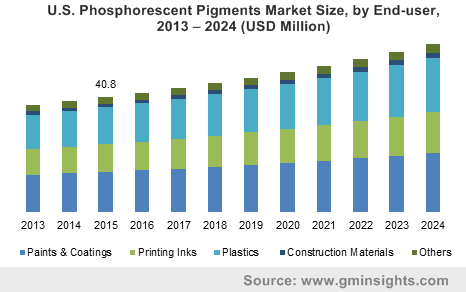Home > Chemicals & Materials > Paints and Coatings > Phosphorescent Pigments Market
Phosphorescent Pigments Market Size
- Report ID: GMI2284
- Published Date: Dec 2017
- Report Format: PDF
Phosphorescent Pigments Market Size
Phosphorescent Pigments Market Size was valued over USD 200 million in 2016 and the industry will grow by a CAGR of around 4.5% up to 2024.

Phosphorescent pigments market will see exponential growth in the coming years owing to its increasing applications in various signage boards and consumer goods. The substance, better known as “glow in the dark” pigments is usually made of fine of zinc sulfide crystals doped with copper. This glow is a result of the unique properties exhibited by crystalline zinc sulfide. Copper activates the crystals to absorb light and gradually emit it with time to generate a dull phosphorescent sheen. Japan based Nemoto & Company later initiated the production of phosphorescent pigments with alkaline earth metals such as strontium under the brand name of LumiNova, which has higher brightness and durability than the conventional zinc sulfide based products. Increasing usage of the product in various signage boards for emergency exits and low-level lighting escape systems as a result of mandatory building and construction guidelines will drive the phosphorescent pigments market in the coming days. The product has serious applications in safety sign boards such as fire exits, escapes, etc. which must be visible in murky and dark environments.
Phosphorescent pigments market is also driven by its use in all types of paint and powder coatings. The powder is added to paints & coatings where the light absorption & releasing process of the products can be repeated continuously. The crystals absorb the light in an illuminated environment and glow in the darkness by emitting the absorbed light. These glow in the dark water based paints are of superior quality and allow the user to create astonishing works in an exceptionally new medium. Moreover, this unique photo-luminescent pigments are also incorporated into many resins and coatings.
Plastics find major applications of phosphorescent pigments market as these are employed in the formulation of plastic sheets & films. The product enhances the glowing properties of the plastics in the absence of light. Lack of radioactive components, long emission time, high durability, outdoor usage, and excellent temperature resistance of the particles ensure appearance of optimum luminous effect in plastic sheets. Major applications of phosphorescent pigments in plastics include automotive interiors, novelty toys, military equipment, wheel coatings, emergency signboards, and packaging.
| Report Attribute | Details |
|---|---|
| Base Year: | 2016 |
| Phosphorescent Pigments Market Size in 2016: | 200 Million (USD) |
| Forecast Period: | 2017 to 2024 |
| Forecast Period 2017 to 2024 CAGR: | 4.5% |
| 2024 Value Projection: | 290 Million (USD) |
| Historical Data for: | 2013 to 2016 |
| No. of Pages: | 160 |
| Tables, Charts & Figures: | 224 |
| Segments covered: | Product, End-user and Region |
| Growth Drivers: |
|
| Pitfalls & Challenges: |
|
Raw materials used in the product manufacturing includes copper activated zinc sulfide powder and strontium aluminate powder. Zinc sulfide is vastly used in the manufacturing of semiconductor materials. Hence, the price of zinc sulfide is affected by the zinc demand and its ores. The prices of strontium aluminate are higher than its substitutes and hence can hamper the phosphorescent pigments industry during the next several years.
